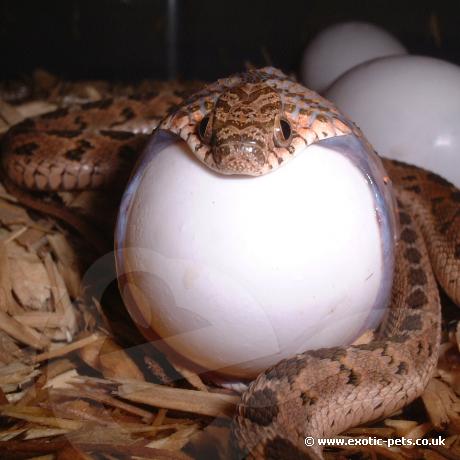

The Egg Eating Snake must be one of the nicest snakes we have ever come across. With no teeth, a calm nature and eating purely on eggs, means no more defrosting them rodents!
This snake is sometimes mistakenly identified as a Night Adder, due to the similar markings. Most are light brown, spotted and lined with black. Teeth are not present in the mouth, but they do have teeth like projections along the backbone to help saw and break the eggs. These teeth start from the base of the skull and continue for approx. 3 inches in adults. A fully grow Egg Eater grows to a size of 60-76cm (24-30 inches) in length.
These are a great species to keep if you are scared of being bitten. The mouth contains no teeth, although some will try and imitate venomous snakes by biting viciously. When they do this, they don't even break the skin! Feeding on fresh eggs means no more defrosting of rodents. Either breed your own finches, quails and chickens or buy them from your local supermarket - most Tesco stores supply quail eggs.
Found in parts of Africa.
This species of snake is very active during the bird-breeding season, climbing through tree branches in search of freshly laid eggs. Provide a daytime temperature of 28-30C (82-86F) with a drop to 25C (77F) during the night. It's best to place a hide/box for humidity, using vermiculite with moss on top. The snake will enter the hide while shedding of the old skin.
Yes, if you can buy or breed fresh bird eggs!
I have used a fine Orchid bark substrate for the flooring with a water dish, and a humidity hide at the cool end of the viv. Place branches, twigs and some artificial plants in the viv to simulate its natural environment, use cork bark on the floor to provide hides. You can even place a false birds nest within the braches and pop the eggs in here. Move the nest around the viv to keep the snake active and healthy. If you do not have access to a false nest you can place the eggs on the floor, but make sure the eggs have been eaten and not pushed under the substrate.
No more defrosting rodents, they eat nothing but fresh bird eggs, be this finch, quail or small chicken eggs. You can feed this species two ways, a few eggs per week or allowing them to eat as much as them want for a few months, then no food while you simulate a wet season. In the wild, these snakes will only eat during the breeding season and must eat as many as they can, even if these means several eggs in one sitting. Then during the rainy season, they basically hide away until the breeding season comes around again. You can feed your snake a few eggs every week if you are not planning on breeding. Leave the eggs in the viv for a few days and then remove to prevent the eggs from going off and attracting bacteria.